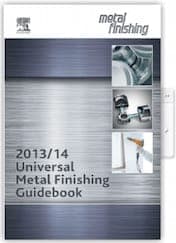
-----
How to plate onto lead
If you are interested in electrodepositing lead, i.e., plating lead onto something else, please see thread 2626; this thread is about plating other materials on to lead.Getting good adhesion of plating requires that the article being plated is clean and free of oxides -- the plated metal must grow onto metal not onto an oxide. The specific problem with plating onto lead is that the usual acids will not remove oxides from lead. The lead surface usually must be activated with fluoride-based acids like fluoboric acid. Read on ...
Q. Hi,
We are in partnership with a fishing lure manufacturing company, who have come to us with a lead lure, which has a bright "chrome" like finish.They would like us to replicate the finish. We suspect that it is nickel plated. Any suggestions on how to plate lead.
- Port Elizabeth, South Africa
2002
(affil links)

free pdf is currently available from academia.edu
A. Nasty stuff to plate. Try Metal Finishing's web site and find their Guidebook. If You do not have the Electroplating Engineering Handbook ⇦ this on eBay, AbeBooks, or Amazon [affil link] edited by Durney, I would buy it. Not cheap, but worth every cent. You will extremely probably have to use a fluoboric acid dip or a sulfuric-fluoboric mixture. The coating is very probably electroless nickel.
James Watts- Navarre, Florida
Ed. update: Sorry, Metal Finishing magazine and its annual Guidebook was owned by Elsevier Science which shut them down in 2013.
A. Hello,
I've plated on lead myself(for X-ray applications) We did this as follows;
Alkaline Electrocleaning (cathodic)
Rinse
Fluoboric acid-dip (10% of 48% fluoboric acid)
Rinse
Copper cyanide strike (5 µm)
Rinse
Decorative nickel plating bath
It's possible to skip the copper strike but we found better adhesion with the copper.
If you ask me, electroless nickel is not an option because lead is a poison for such baths.

Sjamp van Esch
- Eindhoven, The Netherlands
A. I assumed a good copper undercoat when I said EN. You might not get 10 tank turnovers, but I would expect 6 if it was a tiny contact point.
James Watts- Navarre, Florida
![]() Hi all,
Hi all,
Thank you very much for taking the time to respond to my plea. Your comments are greatly appreciated and very helpful.
Regards from Sunny South Africa,
- Port Elizabeth, South Africa
Q. Is there a practical way to copper plate a few small lead alloy objects? If so what chemicals other than copper sulphate
⇦ on
eBay or
Amazon [affil link] and battery acid
⇦ on
eBay
or
Amazon [affil link]
would be involved?
Alloy content percentage is not a given but, mostly lead with, tin, and antimony are likely involved.
hobbyist - Conover, North Carolina, USA
June 4, 2009
A. Forget acid copper plating on lead -- you must use cyanide based plating bath, but you can use old copper tartrate bath, or ferrocyanide based bath too. There are many old and download free electroplating handbooks (by Gore, Watt, Langbein, etc. at www.archive.org website).
hope it helps and good luck!
- Cerovski vrh Croatia
A. Hi Jerry. If you want to use hobbyist home-brews like copper sulphate and battery acid, please start your experiments & practice with plating onto copper or brass items. Plating onto lead with decent adhesion will require dangerous fluoride-based acids like fluoboric or even super hazardous hydrofluoric acid
⇦ why?
. The cyanide which Goran mentioned is an extremely powerful poison, and will release poisonous hydrogen cyanide gas if accidentally acidified; it's not for hobbyist use.
Luck & Regards,

Ted Mooney, P.E. RET
Striving to live Aloha
finishing.com - Pine Beach, New Jersey
Ted is available for instant help
or longer-term assistance.
Q. Hi, I'm looking for the ideal solution to plate copper onto lead in a rotary plater. From reading it would seem that CuSO4 at a certain concentration is the best candidate. First off is that correct? Then are are there any hazardous materials disposal to be concerned with? Thanks much for the help.
David Bolliger- Broomfield, Colorado
July 14, 2012
A. Hi again. I'm afraid that I don't know quite what you mean by 'rotary plater'. Can you expound on that a bit please?
We've appended your 'chemistry/plating inquiry" to a previous discussion of a similar topic. But as for your question about hazardous materials disposal --
A former governor of New Jersey explained the situation very succinctly with eight small words: " 'Toxic' is a matter of statute, not opinion". If you are a hobbyist or a researcher in a university, you may be able to investigate the toxicity of copper sulfate and perhaps decide that it's not all that bad, frequently used at low concentration in lakes & ponds to discourage choking weed growth. But the wastes from Electroplating as small industry is "categorically regulated", meaning that the disposal of all waste from it is regulated, regardless of concentration, even the most dilute final rinses. A hobbyist may not be subject to those regulations, but any shop which sells plating services or sells items that they plate themselves probably is subject to the regulations. Usually, you start the permitting process at your local POTW. Good luck.
Regards,

Ted Mooney, P.E.
Striving to live Aloha
finishing.com - Pine Beach, New Jersey
Ted is available for instant help
or longer-term assistance.
Readers may also be interested in this related thread:
• Topic #294/14 "Copper plating of lead bullets, cheap & simple"
Q, A, or Comment on THIS thread -or- Start a NEW Thread